
The Aristolochiaceae are a family, the birthwort family, of flowering plants with seven genera and about 400 known species belonging to the order Piperales. The type genus is Aristolochia L.

Gelsemium sempervirens is a twining vine in the family Gelsemiaceae, native to subtropical and tropical America: Honduras, Guatemala, Belize, Mexico, and southeastern and south-central United States. It has a number of common names including yellow jessamine or jasmine, Carolina jasmine or jessamine, evening trumpetflower, gelsemium and woodbine.
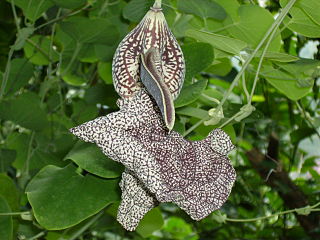
Aristolochia is a large plant genus with over 500 species that is the type genus of the family Aristolochiaceae. Its members are commonly known as birthwort, pipevine or Dutchman's pipe and are widespread and occur in the most diverse climates. Some species, like A. utriformis and A. westlandii, are threatened with extinction.

Cupressus sempervirens, the Mediterranean cypress, is a species of cypress native to the eastern Mediterranean region, in northeast Libya, southern Albania, southern and coastal Bulgaria, southern coastal Croatia, southern Montenegro, southern Bosnia and Herzegovina, southwestern North Macedonia, southern Greece, southern Turkey, Cyprus, northern Egypt, western Syria, Lebanon, Malta, Italy, Palestine, Israel, western Jordan, South Caucasus, and also a disjunct population in Iran.
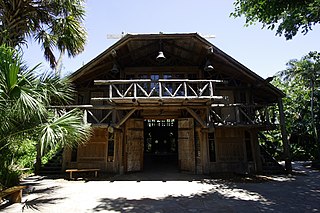
The McKee Botanical Garden is a non-profit, subtropical botanical garden in Vero Beach, Florida. It is located at 350 U.S. Highway 1, Vero Beach, Florida. It was founded in 1929, when Waldo Sexton and Arthur G. McKee purchased an 80-acre (32 ha) tropical hammock along the Indian River. Tropical landscape architect William Lyman Phillips was hired to design its streams, ponds, and trails. Its indigenous vegetation was augmented with ornamental plants and seeds from around the world. In 1932, they proceeded to open the garden, then known as McKee Jungle Gardens, as a tourist attraction. Although the Garden was successful for several decades, it shut down in 1976, and most of its land was sold for development. The site remained vacant for twenty years until the Indian River Land Trust purchased it in 1995. The current Garden was formally dedicated in 2001. It is now a Florida landmark and on January 7, 1998, it was added to the U.S. National Register of Historic Places under its former name of McKee Jungle Gardens. Currently, there are several buildings on the garden including the office, gift shop, education center and a restaurant.
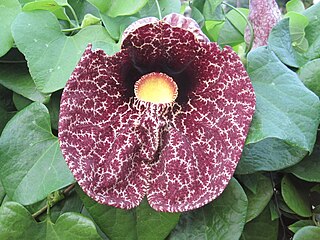
Aristolochia littoralis, the calico flower or مورپنکھ بیل orelegant Dutchman's pipe, is a species of evergreen vine belonging to the family Aristolochiaceae.

Aristolochia rotunda, commonly known as smearwort or round-leaved birthwort, is a herbaceous perennial plant native to Southern Europe.

Aristolochia labiata, the mottled Dutchman's pipe or rooster flower, is an ornamental plant which is native to Brazil.

Archon apollinus, the false Apollo, is a species of butterfly belonging to the Parnassinae subfamily.

Laurelia sempervirens, commonly called Peruvian nutmeg, from mapuche: tihue, trihue, also called Chilean laurel or Chilean sassafras. It is a species of Evergreen tree in the family Atherospermataceae, formerly Monimiaceae, in the southern hemisphere genus of plant Laurelia, not closely related to Lauraceae despite the similarity. It is endemic to Chile. It occurs 34–41° South Latitude. They require a warm subtropical to tropical climate that is cool but also frost-free or with only very slight winter frosts not below -4 °C, and with high summer heat, rainfall, and humidity. This is, the laurel forest habitat. The Tihue grows best on well-drained, slightly acidic soils rich in organic matter.

Acer sempervirens, the Cretan maple, is a species of maple native to southern Greece and southern Turkey.
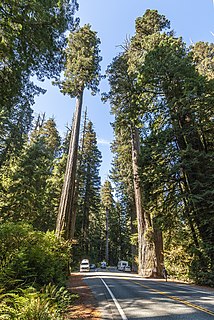
Sequoia sempervirens is the sole living species of the genus Sequoia in the cypress family Cupressaceae. Common names include coast redwood, coastal redwood and California redwood. It is an evergreen, long-lived, monoecious tree living 1,200–2,200 years or more. This species includes the tallest living trees on Earth, reaching up to 115.5 meters (379 ft) in height and up to 8.9 meters (29.2 ft) in diameter at breast height (dbh). These trees are also among the oldest living things on Earth. Before commercial logging and clearing began by the 1850s, this massive tree occurred naturally in an estimated 810,000 hectares along much of coastal California and the southwestern corner of coastal Oregon within the United States.

Sequoia is a genus of redwood coniferous trees in the subfamily Sequoioideae of the family Cupressaceae. The only extant species of the genus is Sequoia sempervirens in the Northern California coastal forests ecoregion of Northern California and Southwestern Oregon in the United States. The two other genera, Sequoiadendron and Metasequoia, in the subfamily Sequoioideae are closely related to Sequoia. It includes the tallest trees, as well as the heaviest, in the world.

Aristolochia didyma, or yawar panga is a plant found in South America of the genus Aristolochia. It is a powerful purgative, sometimes used in traditional rites to purify the body a few days before an Ayahuasca session.

Battus crassus, the Crassus swallowtail, is a species of butterfly from the family Papilionidae.

Aristolochia gibertii is a species of perennial plant in the family Aristolochiaceae. It is found in Argentina, Bolivia, and Paraguay.

Aristolochia tricaudata is a species of perennial plant in the family Aristolochiaceae. It is found in Chiapas and Oaxaca, Mexico.
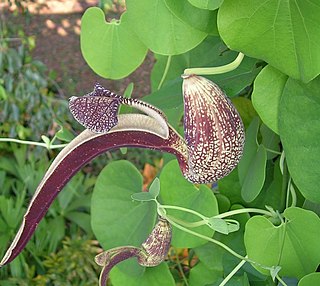
Aristolochia ringens is a species of perennial plant in the family Aristolochiaceae. It is found from Panama through Bolivia, Colombia, and Venezuela.

Aristolochia pontica is a species of perennial plant in the family Aristolochiaceae. It is found in the Republic of Georgia, Turkey, Lebanon, and Greece.

Aristolochia fimbriata is a species of perennial plant in the family Aristolochiaceae. It is found in Brazil, Paraguay, Bolivia, Uruguay, and Argentina. The flowering plant attracts butterflies and is known for its traditional medicinal properties.
























